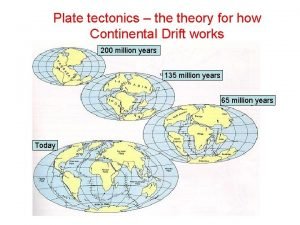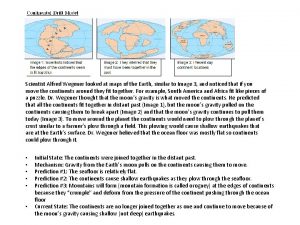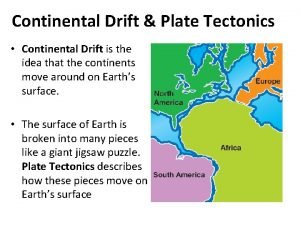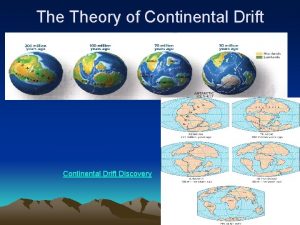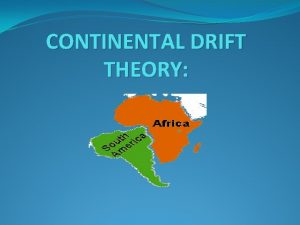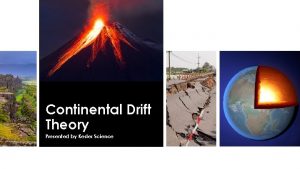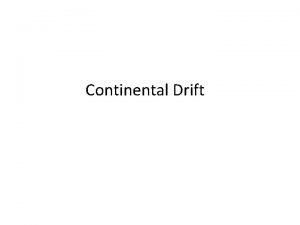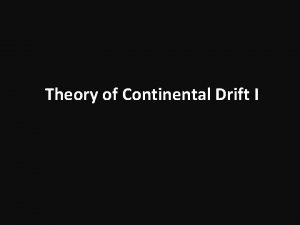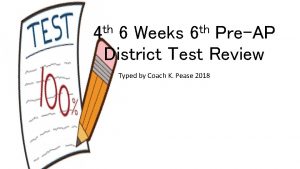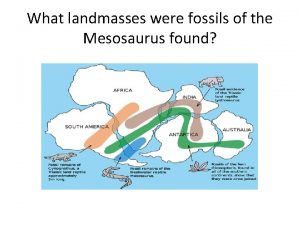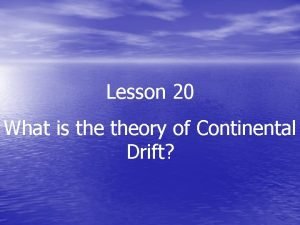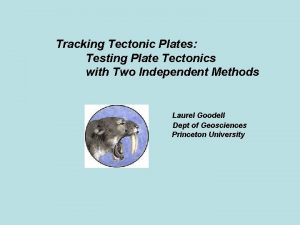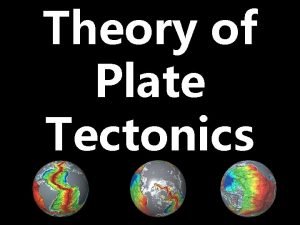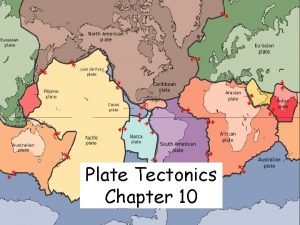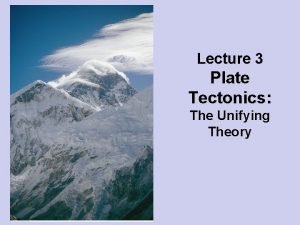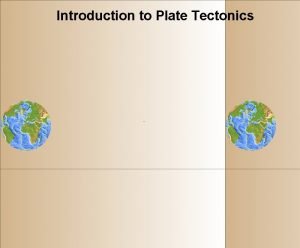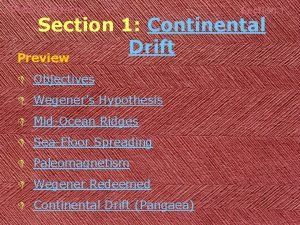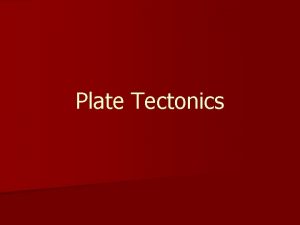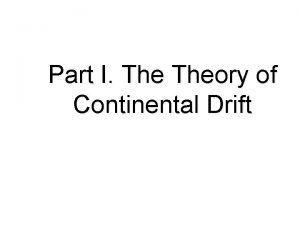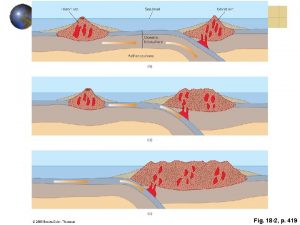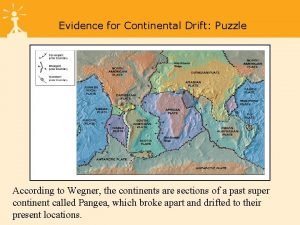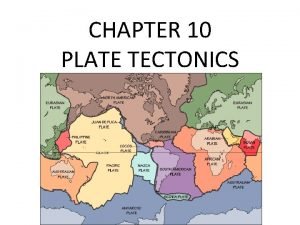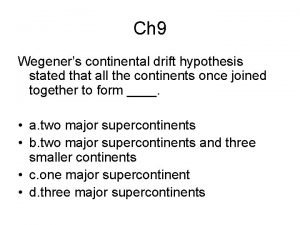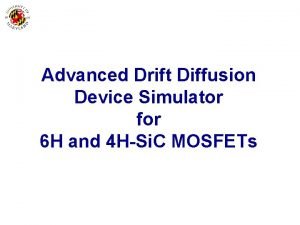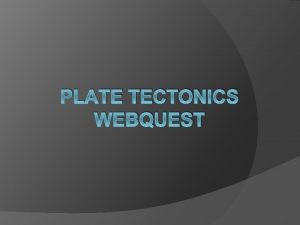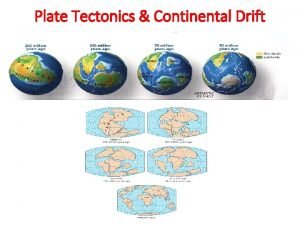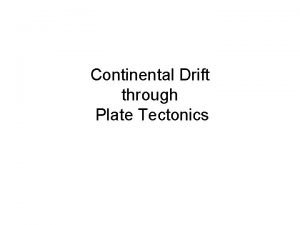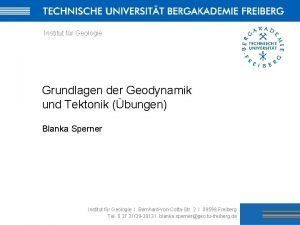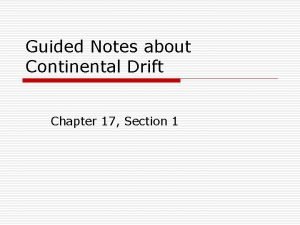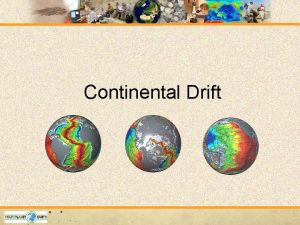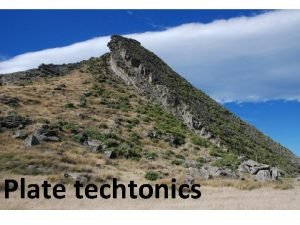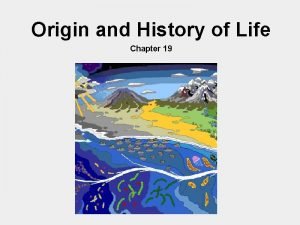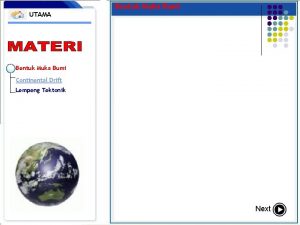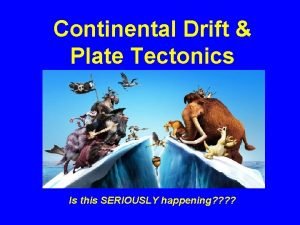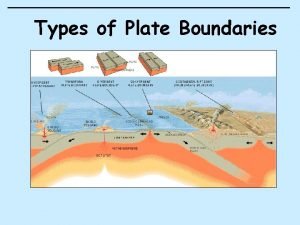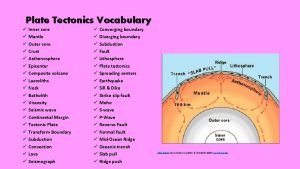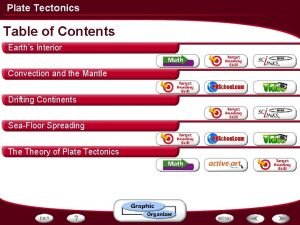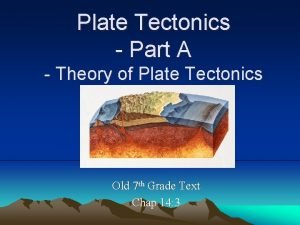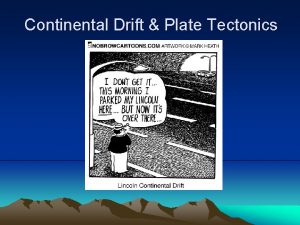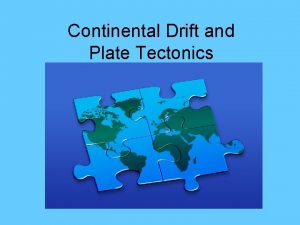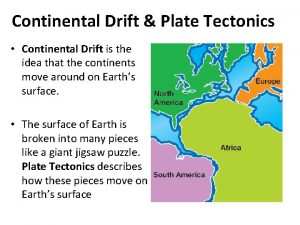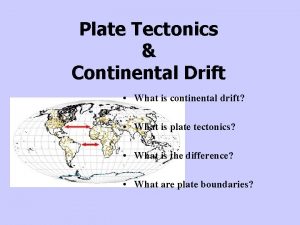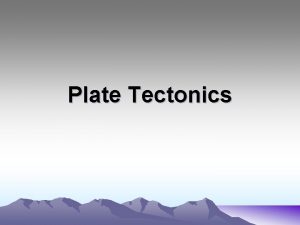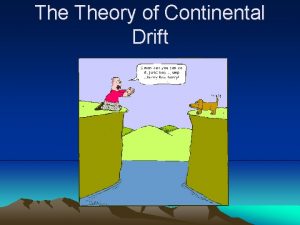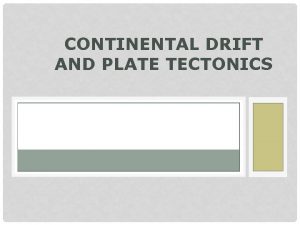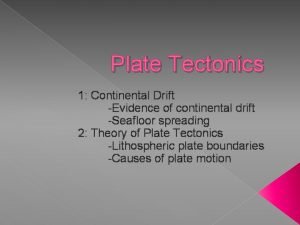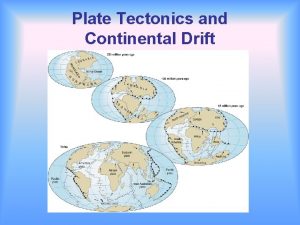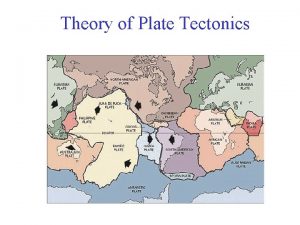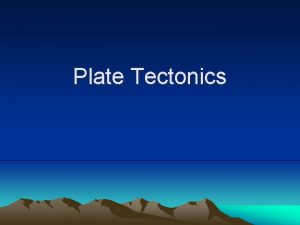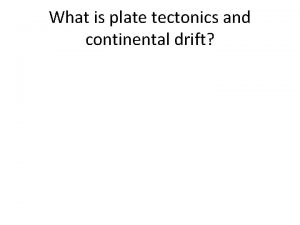Plate Tectonics Continental Drift n Theory that the

















































- Slides: 49

Plate Tectonics


Continental Drift n Theory that the continents were once all one large super continent and have since drifted apart. n Pangea n Proposed by Alfred Wegner in 1912

Pangea

Evidence for Continental drift Shape of continents look like they fit together 2. Mineral and rock formations on each continent. 3. Fossil evidence 4. Mountain ranges 5. Past climates *This theory gives no explanation for why the continents move. 1.

Mineral evidence

Fossil Evidence

Mountain range evidence


Untold tragedies of continental drift

World War II provides improved theory called Sea Floor Spreading n Discoveries made from exploration of ocean bottom.


Sea Floor Spreading n Theory that the sea floor is spreading apart at an undersea chain of mountains called the mid-ocean ridge n Mid-ocean ridge – Undersea chain of mountains extends around the earth – Largest feature on earth n Rift Valley – Central crack in the mid ocean ridge where new crustal material is formed

Mid Ocean Ridge

Rift valley

Evidence for Sea Floor Spreading 1. Rock age – As you go further from the ridge the age of the rocks gets older. • There is a matching pattern on each side 2. Rock Magnetism – There is a matching pattern of alternating polarity reversals on each side of the ridge.

Rock age and Magnetism

Sea Floor Spreading n Scientists thought the rising magma pushed the continents apart – This was disproven by physicists


Plate Tectonics n Theory that the earth’s crust is made up of several large pieces called plates n Plates are “floating” on the partialy molten asthenosphere n Plates move around n Ocean crust density is 3. 0 n Continental crust density is 2. 7

What makes plates move n Huge convection cells in the mantle

Convection cells

Three Types of Plate Boundaries 1. Convergent – 2 plates moving together (colliding) 2. Divergent – 2 plates moving apart 3. Transform – 2 plates moving past one another.

There are Three Types of Convergent Plate Boundaries n Oceanic Plate with Continental Plate n Oceanic Plate with Oceanic Plate n Continental Plate with Continental Plate

Convergent Plate Boundary – (Oceanic – Continental) Example : Peru – Chile Trench – See ERT

Convergent Plate Boundary (oceanic / continental collision) n n n 1. ocean plate is more dense than continental plate therefore goes under continent. 2. deep sea trench is formed 3. mountain building processes 4. earthquake activity due to the contact between plates 5. volcanism due to the melting of the plate materials [meting of continental (felsic) material causes explosive volcanoes]

Subduction Zone n Subduction Zone – Convergent plate boundary where one plate is pulled under another to be re-melted in the mantle

Convergent Plate Boundary (oceanic – oceanic plates collide) Example: Aleutian Islands, Islands of Japan


Convergent Plate Boundaries (oceanic plate - oceanic plate collision) 1. 2. 3. 4. Subduction Island Arch – Partial melting of plate forms a curved line of volcanic islands oceanic trench earthquakes at plate contact

Continent – Continent plate boundary

Convergent Plate Boundary (continental – continental ) n 1. Major mountain building due to extreme folding of the continental crust (some of the highest mountains in the world form) n 2. One plate is subducted with much resistance forming huge mountains.

Himalayan Mountains

Divergent Plate Boundary Example: Mid-Atlantic Ridge

Divergent Plate Boundary n Mid-Ocean Ridges – Oceanic plates move away from each other. n Characteristics: n 1. mid-ocean ridges n 2. rift valley n 3. new ocean floor material (basalt – dense, mafic)

Transform plate boundary

Transform Plate Boundary n Transform Plate Boundary – Two plates slip past each other n Characteristics: n 1. plates move in opposite directions while moving parallel to each other.

Transform Plate Boundary n Example: San Andreas Fault (California)

Transform Plate Boundary

San Andreas Fault

The San Andreas Fault Running Through An Orchard n see the diagonal line that runs through the orchard in the incredible photo above? that's the san andreas fault - a point where the edges of 2 tectonic plates meet producing a visible displacement amongst the rows of trees. when they were planted years ago the rows were straight, but as the 2 ginormous land masses moved in opposite directions and rubbed against each other over the years the orchard was split. the top half of the field sits on the pacific plate, the bottom half on the north american plate.

Earthquake occurrences


Hot spots n Area at the center of a plate where molten material has melted through the plate and created a volcano – Hawaiian islands are over a hot spot

3 parts of the continent n Shield – Oldest part of the continent n Stable Platform – Area of undisturbed sediments eroded from the shield. Flat horizontal layers n Folded mountains – area of folded faulted rocks at the edge of the continent.

Canadian Shield

Continental Accretion n Growth of the continent through addition of material at its edges – Oldest part of continent is in the center

Isostacy n. A state of balance in the earths crust. Any change in one part of the crust will be offset by and equal and opposite change in another part. – Crust is floating on the mantle – Crust is thickest under the continents thinnest under the ocean

Geosyncline n. A place where the earths crust is sinking as sediments are piled into it. – Sediment layers thousands of feet thick build up
 Convergent boundary divergent boundary transform boundary
Convergent boundary divergent boundary transform boundary Plate tectonics vs continental drift
Plate tectonics vs continental drift Convergent plate boundary
Convergent plate boundary Plate tectonics vs continental drift
Plate tectonics vs continental drift Compare continental drift and plate tectonics
Compare continental drift and plate tectonics A denser oceanic plate collides with a continental plate
A denser oceanic plate collides with a continental plate Divergent boundary oreo
Divergent boundary oreo Wegners theory
Wegners theory Earths mantle
Earths mantle Plates fit like a puzzle
Plates fit like a puzzle Continental drift theory
Continental drift theory Continental drift theory
Continental drift theory Proof of continental drift theory
Proof of continental drift theory Proof of continental drift theory
Proof of continental drift theory Continental drift
Continental drift Continental drift theory slideshare
Continental drift theory slideshare Continental drift
Continental drift Plate motion calculator
Plate motion calculator Plate tectonics theory states that
Plate tectonics theory states that Summarize the theory of plate tectonics
Summarize the theory of plate tectonics Lithosphere definition
Lithosphere definition Unifying theory of plate tectonics
Unifying theory of plate tectonics Theory of plate tectonics
Theory of plate tectonics Section 1 continental drift
Section 1 continental drift Evidence of continental drift
Evidence of continental drift Fossil correlation continental drift
Fossil correlation continental drift Fossils as evidence of continental drift
Fossils as evidence of continental drift Continental drift puzzle
Continental drift puzzle Chapter 10 plate tectonics
Chapter 10 plate tectonics What type of
What type of Continental drift simulator
Continental drift simulator Continental drift
Continental drift Plate tectonics webquest answers
Plate tectonics webquest answers Continental drft
Continental drft Continental drift warm up
Continental drift warm up Continental drift michael sammartano
Continental drift michael sammartano Continental drift adalah
Continental drift adalah Continental drift notes
Continental drift notes Similar fossils found on different continents
Similar fossils found on different continents Paleoglaciation continental drift
Paleoglaciation continental drift Continental drift
Continental drift Muka lempeng adalah
Muka lempeng adalah Continental drift
Continental drift Convergent boundary with subduction
Convergent boundary with subduction Convergent plate boundary
Convergent plate boundary Convergent boundary
Convergent boundary Plate tectonics vocabulary worksheet
Plate tectonics vocabulary worksheet Plate tectonics
Plate tectonics Plate tectonics definition
Plate tectonics definition Driving force of plate tectonics
Driving force of plate tectonics


